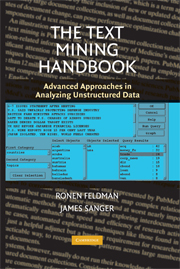Book contents
- Frontmatter
- Contents
- Preface
- I Introduction to Text Mining
- II Core Text Mining Operations
- III Text Mining Preprocessing Techniques
- IV Categorization
- V Clustering
- VI Information Extraction
- VII Probabilistic Models for Information Extraction
- VIII Preprocessing Applications Using Probabilistic and Hybrid Approaches
- IX Presentation-Layer Considerations for Browsing and Query Refinement
- X Visualization Approaches
- XI Link Analysis
- XII Text Mining Applications
- Appendix A DIAL: A Dedicated Information Extraction Language for Text Mining
- Bibliography
- Index
IX - Presentation-Layer Considerations for Browsing and Query Refinement
Published online by Cambridge University Press: 08 August 2009
- Frontmatter
- Contents
- Preface
- I Introduction to Text Mining
- II Core Text Mining Operations
- III Text Mining Preprocessing Techniques
- IV Categorization
- V Clustering
- VI Information Extraction
- VII Probabilistic Models for Information Extraction
- VIII Preprocessing Applications Using Probabilistic and Hybrid Approaches
- IX Presentation-Layer Considerations for Browsing and Query Refinement
- X Visualization Approaches
- XI Link Analysis
- XII Text Mining Applications
- Appendix A DIAL: A Dedicated Information Extraction Language for Text Mining
- Bibliography
- Index
Summary
Human-centered knowledge discovery places great emphasis on the presentation layer of systems used for data mining. All text mining systems built around a human-centric knowledge discovery paradigm must offer a user robust browsing capabilities as well as abilities to display dense and difficult-to-format patterns of textual data in ways that foster interactive exploration.
A robust text mining system should offer a user control over the shaping of queries by making search parameterization available through both high-level, easy-to-use GUI-based controls and direct, low-level, and relatively unrestricted query language access. Moreover, text mining systems need to offer a user administrative tools to create, modify, and maintain concept hierarchies, concept clusters, and entity profile information.
Text mining systems also rely, to an extraordinary degree, on advanced visualization tools. More on the full gamut of visualization approaches – from the relatively mundane to the highly exotic – relevant for text mining can be found in Chapter X.
BROWSING
Browsing is a term open to broad interpretation. With respect to text mining systems, however, it usually refers to the general front-end framework through which an enduser searches, queries, displays, and interacts with embedded or middle-tier knowledge-discovery algorithms.
The software that implements this framework is called a browser. Beyond their ability to allow a user to (a) manipulate the various knowledge discovery algorithms they may operate and (b) explore the resulting patterns, most browsers also generally support functionality to link to some portion of the full text of documents underlying the patterns that these knowledge discovery algorithms may return.
Information
- Type
- Chapter
- Information
- The Text Mining HandbookAdvanced Approaches in Analyzing Unstructured Data, pp. 177 - 188Publisher: Cambridge University PressPrint publication year: 2006
